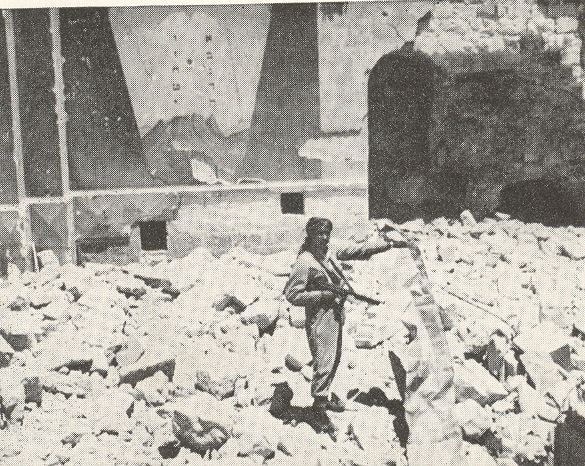 | ||
Islamization of East Jerusalem under Jordanian occupation is what occurred during the Jordanian occupation of the West Bank between 1948–1967, when Jordan sought to alter the demographics and landscape of the city to enhance its Muslim character. At this time, all Jewish residents were expelled, and restrictions were imposed on the Christian population that led many to leave the city. Ghada Hashem Talhami states that during its nineteen years of rule, the government of Jordan took actions to accentuate the spiritual Islamic status of Jerusalem. Raphael Israeli, an Israeli professor, described these measures as "Arabization".
Contents
Treatment of Jews and Jewish holy sites
While Christian holy sites were protected, and Muslim holy sites were maintained and renovated, Jewish holy sites were damaged and sometimes destroyed. According to Raphael Israeli, 58 synagogues were desecrated or demolished in the Old City, resulting in the de-Judaization of Jerusalem. The Western Wall was transformed into an exclusively Muslim holy site associated with al-Buraq. 38,000 Jewish graves in the ancient Jewish cemetery on the Mount of Olives were systematically destroyed, and Jews were not allowed to be buried there. Following the Arab Legions expulsion of the Jewish residents of the Old City in the 1948 War, Jordan allowed Arab Muslim refugees to settle in the vacated Jewish Quarter. Later, after some of these were moved to Shuafat, migrants from Hebron took their place. During the 1960s, as the quarter continued to fall into decay, Jordan planned to turn the quarter into a public park.
Treatment of Christians and Christian holy sites
In 1952, Jordan proclaimed that Islam was to be the official religion, and according to Israeli professor Yehuda Zvi Blum, this was applied in Jordanian-held Jerusalem.
In 1953, Jordan restricted Christian communities from owning or purchasing land near holy sites, and in 1964, further prohibited churches from buying land in Jerusalem. These were cited, along with new laws impacting Christian educational institutions, by both British political commentator Bat Ye'or and the mayor of Jerusalem Teddy Kollek as evidence that Jordan sought to "Islamize" the Christian Quarter of the Old City of Jerusalem.
In order to counter the influence of foreign powers, who had run the Christian schools in Jerusalem autonomously since Ottoman times, the Jordanian government legislated in 1955 to bring all schools under government supervision. They were allowed to use only approved textbooks and teach in Arabic. Schools were required to close on Arab national holidays and Fridays instead of Sundays. Christian holidays were no longer recognised officially, and observation of Sunday as the Christian Sabbath was restricted to Christian civil servants. Christian students could study their own religion, but lessons in Koran were declared mandatory. Some say there is no clear evidence that these laws were implemented, but according to Blum, they were strictly enforced.
In general, Christian holy places were treated with respect, although some scholars say they suffered from neglect. During this period, renovations were made to the Church of the Holy Sepulchre, which was in a state of serious disrepair since the British period due to disagreements between the many Christian groups claiming a stake in it. While there was no major interference in the operation and maintenance of Christian holy places, the Jordanian government did not allow Christian institutions to expand, and banned them from purchasing land. Christian churches were prevented from funding hospitals and other social services in Jerusalem.
In the wake of these restrictions, many Christians left East Jerusalem.
